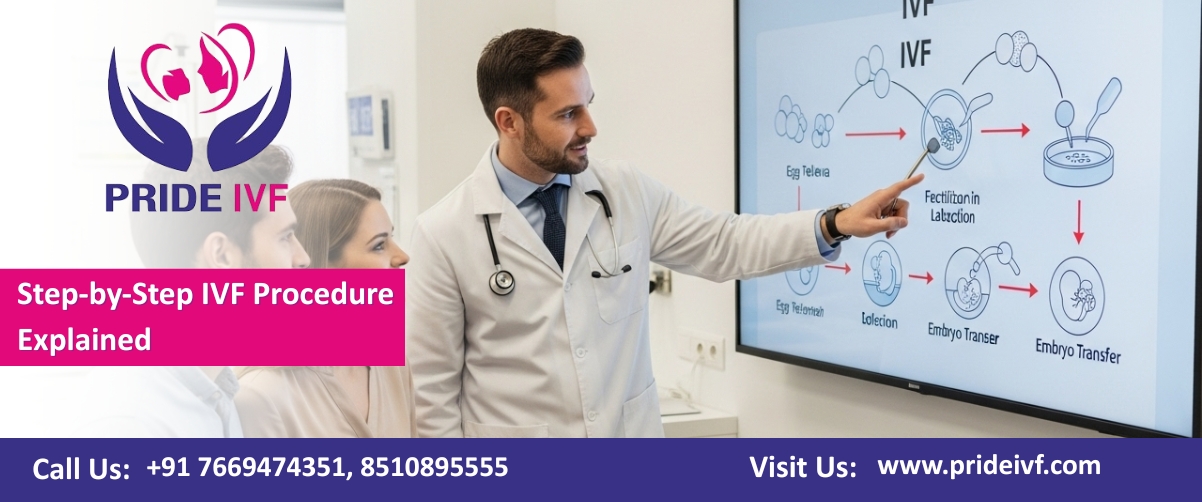Many couples today struggle to conceive naturally, and infertility is a growing global concern. Despite the fact that infertility can affect both men and women, medical science has advanced significantly in providing efficient treatments. IVF, or in vitro fertilization, is one of the most effective techniques. Millions of couples have been able to realize their dream of parenthood thanks to this cutting-edge procedure. The detailed IVF process, its significance, and the critical role a male infertility specialist plays in the process will all be covered in this blog.
Understanding IVF
IVF (In Vitro Fertilization) is a type of Assisted Reproductive Technology (ART) where eggs are collected from the woman and sperm from the man, and fertilization is carried out in a laboratory. The resulting embryo is then transferred into the woman’s uterus for implantation and pregnancy.
The process is detailed and requires precision, expertise, and proper medical guidance. Let’s dive into the IVF process step by step.
Step 1: Fertility assessment and initial consultation
A fertility specialist consultation is the first step in the IVF process. Each partner has a physical examination, fertility tests, and a review of their medical history.
- Women: Evaluations are conducted on uterine health, ovarian reserve, and hormone levels.
- For men: Sperm count, motility, and morphology are examined through a semen analysis.
A male infertility specialist intervenes when male factor infertility is identified to determine whether the problem is structural, motility, or low sperm count.
It may be recommended to use advanced sperm retrieval techniques, medication, or lifestyle modifications.
Step 2: Stimulation of the Ovaries
The female partner starts ovarian stimulation as soon as the couple is considered suitable for IVF. In order to encourage the ovaries to produce multiple mature eggs rather than the single egg produced during a natural cycle, fertility medications and hormone injections are prescribed.
Follicle growth and hormone levels are tracked with routine blood tests and ultrasounds. Getting as many healthy eggs as you can for fertilization is the aim.
Step 3: Oocyte Pick-Up (Egg Retrieval)
Egg retrieval comes next when the eggs are sufficiently developed. Under anesthesia, a minor surgical procedure is performed.
- A tiny needle is inserted into the ovarian follicles through the vaginal wall under ultrasound guidance.
- The eggs are collected in a lab dish after being gently aspirated.
The patient usually recovers in a few hours after the 20–30 minute procedure.
Step 4: Preparing and Gathering Sperm
A sample of semen is provided by the male partner on the same day as the egg is retrieved. A male infertility specialist will perform advanced procedures like TESA (Testicular Sperm Aspiration) or MESA (Microsurgical Epididymal Sperm Aspiration) if natural ejaculation is not feasible or if the sperm count is extremely low.
To choose the most healthy and motile sperm for fertilization, the collected sperm are subsequently cleaned and prepared in the laboratory.
Step 5: Process of Fertilization
In IVF, there are primarily two methods of fertilization:
- Traditional IVF: In order to facilitate natural fertilization, sperm and eggs are arranged in a culture dish.
- In intracytoplasmic sperm injection, or ICSI, a single healthy sperm is injected straight into the egg; this procedure is frequently advised for male infertility.
For three to five days, the fertilized eggs (embryos) are closely observed in the lab.
Step 6: Embryo Culture and Selection
Embryos are monitored for cell division, growth, and quality throughout the culture period. The top-quality embryos are chosen for transfer by the embryologist. Additional embryos can be cryopreserved (frozen) for later use.
Only the healthyest embryos with the best chances of implantation are selected thanks to embryo grading.
Step 7: Embryo Transfer
One of the most important phases in the IVF procedure is this. Typically, it is carried out three or five days following fertilization.
- The chosen embryo or embryos are transferred into the woman’s uterus using a thin catheter.
- Although there is no pain involved, some women may experience some minor discomfort.
For the best results, rest and stress-free living are recommended following embryo transfer.
Step 8: Luteal Phase Support
To improve the chances of implantation, progesterone supplements are given to support the uterine lining. This ensures the uterus is well-prepared to nourish and hold the developing embryo.
Step 9: Pregnancy Test
About 12–14 days after embryo transfer, a blood test is conducted to measure hCG (human chorionic gonadotropin) levels. A positive result confirms pregnancy. If successful, the couple can continue with normal prenatal care. If not, the doctor may suggest another cycle with adjustments.
A Male Infertility Specialist’s Function in IVF
Although IVF is frequently thought of as a treatment for female infertility, male factors account for nearly 40% of infertility cases. A specialist in male infertility is essential in:
- Making diagnoses for disorders like blockages, low sperm count, poor motility, or DNA fragmentation.
- Making suggestions for medication, surgery, or changes to one’s way of life.
- When natural sperm collection isn’t feasible, using sophisticated sperm retrieval techniques.
- Working together with embryologists to guarantee that the best sperm are utilized for fertilization.
Effectively treating male infertility greatly improves the likelihood of IVF success.
IVF Success Factors
A woman’s age (younger age generally means higher chances) is one of several factors that affect the success rate of IVF.
- Sperm and egg quality.
- Health of the uterus.
- Lifestyle choices such as stress, alcohol, or smoking.
- Knowledge of the embryology lab and fertility team.
Many couples can achieve success rates of 40% to 60% per cycle with modern IVF techniques if they receive the proper care.
Final Thoughts
IVF is truly a ray of hope for couples struggling with infertility. The step-by-step IVF procedure is designed with scientific precision to maximize the chances of pregnancy. From ovarian stimulation to embryo transfer, every stage requires careful monitoring and medical expertise.
It’s also important to remember that infertility is not just a “female issue.” Men also contribute equally, and seeking help from a male infertility specialist can make all the difference. With the right diagnosis, treatment, and emotional support, IVF can help couples welcome the joy of parenthood into their lives.




